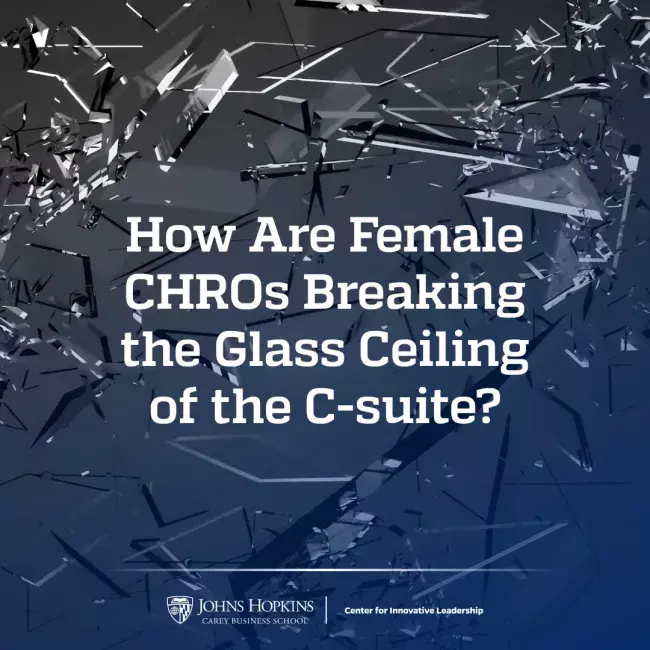Contrasting with an underrepresentation of women in other top rank senior roles, new analysis reveals an encouraging increase in female CHROs—which may help us better understand decisions relating to gender diversity, or lack of it, at the top of organizations.

How Female CHROs Break the Glass Ceiling of the C-suite
Summary
With as many females as males graduating from top universities today, the question as to why women still tend not to rise to the most senior management positions in business, remains unanswered. ‘Glass ceilings’ have not shattered in the way they were once projected to.
A new study into the appointment of women CHROs (Chief HR Officers) throws light on some of the challenges facing women in executive roles, who aspire to C-suite positions. The dynamics at play when women are appointed as CHROs, especially when chosen to succeed a man, may be informative. Appointment decisions may be consistent with 'social role theory’—where women are perceived as preternaturally good at HR—or with ‘social categorization theory’—where in a predominantly male boardroom environment women, seen as outsiders, are less likely to be appointed. The way these decisions and processes play out has implications for gender diversity in all senior positions.
Glass ceilings never went away
Recent decades have seen rising institutional pressures for greater gender diversity at senior levels of organizations. Employees, customers, media, and governments press for diversity for reasons of fairness, but also with an increasing awareness around the benefits of diverse perspectives—especially in view of social and environmental issues. Investors and senior management will also be influenced by mounting evidence that diversity brings competitive advantage for the organization.
Despite this the increase in numbers of female executives in top management positions is painfully slow. A 2016 survey of S&P 1500 companies found only 9% of senior executives (defined as CEOs, CFOs, and the next three highest paid executives) to be female, with a mere 5.1% of CEOs being women. The CHRO position stands in marked contrast to this, with the profession, across the US, moving closer to gender parity. In fact, in the S&P 500, women have occupied the role in more than 50% of firms in recent years.
To understand this divergence in gender diversity between C-suite roles, it is useful to examine the forces at work for and against the appointment of a female CHRO, particularly when a woman is chosen to succeed a previous male CHRO. A recent study by CIL Core Faculty member Richard Smith, Professor of Practice and Vice Dean for Education and Partnerships at Johns Hopkins Carey Business School, and his colleagues, looked at these dynamics from the perspective of two acknowledged and competing models—social role theory and social categorization theory.
Persistent social forces
On the one hand, as consistent with social role theory, the CHRO position may be perceived as an ideal position for women because HR is widely thought to be a female domain—with a high proportion of women in lower ranked HR roles, and where female-associated traits such as emotional intelligence, empathy, and strong administrative skills, are seen to suit HR roles well—including at senior executive level. On the other hand, in line with social categorization theory, women can be considered as ‘outsiders’ by members of a typical male-dominated top management team and, regardless of the gendered social role perception of HR, can be excluded from the CHRO position as being less acceptable to the board than male candidates.
Over recent decades, there has been a growing appreciation that prioritizing human capital and employee development is key to organizational success and sustainability. Consequently, most large companies now have a CHRO on the board or as a part of the senior leadership team. At the same time the nature and responsibilities of the role has broadened from a highly administrative function, to now include: strategic advisor to the executive team, coach to the executive team, liaison to the board of directors, talent architect, leader of the HR function, and representative to and from the workforce.
To some extent gender stereotypes are also projected onto HR roles due to the historical predominance of women in these roles. There is also the more general and common stereotype that women are well suited for compassionate, people-caring occupations, aligned with the perception of HR as a people-centered profession. Allied to the belief that women may be best placed to handle the large administrative component of most HR roles, one would expect the dominant perception within an organization to equate the CHRO role as a female role. One-Nil to social role theory?
Not so. The authors found that social perception of the HR function alone is not sufficient to cause a gender shift in the CHRO role—i.e. a male predecessor being replaced by a female. A key reason for this, and for the low ratio of women in senior management positions, is that women are often seen by the predominantly male members of the senior management team as being from an ‘out-group’. Senior male management teams will tend to exclude women candidates, using automatic judgments based on unconscious biases. What is more, while large companies will have guidelines and processes to support diversity at junior and middle management levels, these are unlikely to apply at the senior leadership level. So, although firms are under institutional pressures to appoint more women to top leadership roles, there are also plenty of competing forces and biases based on social categorization, that function to resist such pressures. One-All.
Positive external dynamics
Two imitative, external dynamics can operate to counter the effects of social role and social categorization theories.
First, the CEO’s exposure to other firms’ practice in terms of managerial gender diversity. If the firm’s male CEO has held a position on the board of another company where a C-level position is occupied by a woman, especially if he has witnessed the presence of a female CHRO, his social categorization bias may be defused. Consequently, being under pressure to promote diversity in the organization anyway, he may be prompted to exert significant influence on his leadership team to select a female candidate.
Secondly, imitating industry-wide practice can play a part. As a rule, CEOs and senior managers tend to follow precedents set across their industry, in terms of culture, values and attitudes. The prevalence of female CHROs varies significantly by industry, and the pressure for greater diversity from stakeholders will also vary according to industry—but where industries have a high proportion of female CHROs, it is more likely that a gender shift from a male to a female CHRO will take place, when the position becomes vacant.
Break glass to access
The CHRO appointment story is a largely positive one—though it also shows that even in a profession seen to be female oriented, reaching the top job is difficult, and glass ceilings still exist and often prevail. Using the example of S&P 500 firms, the authors found that when the predecessor CHRO is a man, management is more likely to appoint another man to be their successor, which is consistent with the predictions of social categorization theory. This is despite the fact that the HR function is perceived as a female domain based on common stereotypes, and that we are at a point in time when organizations are under pressure from investors and other stakeholders to improve gender diversity.
Despite the helpful tailwinds of pro-diversity zeitgeist, women still face a significant hurdle to be promoted to CHRO that their male counterparts do not. The hurdles are higher still for women aspiring to other C-level roles, where social role theory does not assist them as a mitigating factor.
Cause for some optimism exists in the external dynamics that can counter these hurdles. Other C-suite decision makers gaining exposure to female leaders in the C-suite at other firms, and industry-wide practice as greater diversity increases on a wider scale. Both trends take time, but the trajectory is a positive one. Finally, the emergence of the Chief Sustainability Officer (CSO) in recent years adds an ‘extra seat at the table’ that may possess some similar dynamics to that of the CHRO position. Female representation in CSO roles in the U.S. rose to 54 percent in 2021 from 28 percent in 2011, and there is research showing that women are the most likely changemakers for climate action that can help explain this.
The Center for Innovative Leadership (CIL) at the Carey Business School aims to advance knowledge and build capacity for innovative leadership in modern organizations. CIL is a hub for new ideas and insights on leadership, combining faculty-led research, student-facing programming, and community-focused impact.


